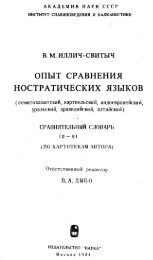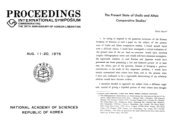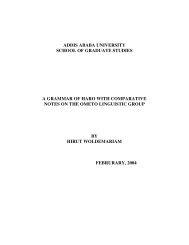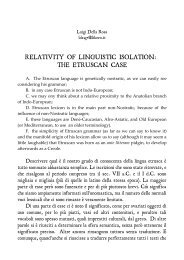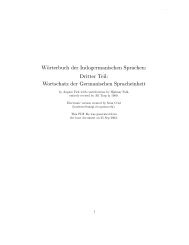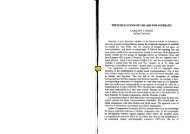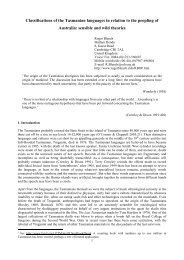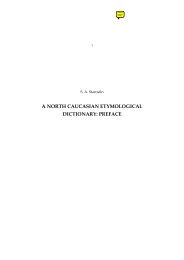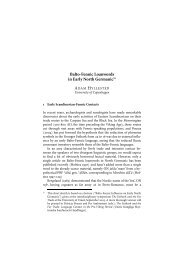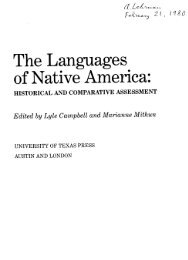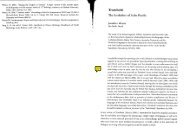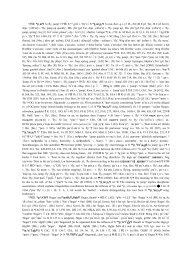The Indo-European Elements in Hurrian
The Indo-European Elements in Hurrian
The Indo-European Elements in Hurrian
You also want an ePaper? Increase the reach of your titles
YUMPU automatically turns print PDFs into web optimized ePapers that Google loves.
68 6. Verbal Morphology<br />
This formation can be compared with the suffix -mmi- used to create verbal adjectives<br />
from active-transitive verbs <strong>in</strong> Luwian with<strong>in</strong> <strong>Indo</strong>-<strong>European</strong>: ayammi- ‘done’ (aya- ‘to<br />
do’), *piyami- ‘given’ (piya- ‘to give’), kišammi- ‘combed’ (kiša(i)- ‘to comb’),<br />
dupaimmi- ‘struck’ (dupa(i)- ‘to strike’). Note also the suffix *-mo-, which is used to<br />
create participles <strong>in</strong> Balto-Slavic and Oscan-Umbrian. F<strong>in</strong>ally, there are the extended<br />
suffixes *-mno-/*-mnā- and *-meno-/*-menā-, *-meno-/*-menā-, which are used to create<br />
middle (passive) participles from tense stems end<strong>in</strong>g <strong>in</strong> the thematic vowel *-e/o-.<br />
2. Another one is a past participle -iri-, which expresses completed transitive action:<br />
a) pa- ‘to build’, hence pairi ‘(who has) built’ KBo 32.14 Vo 37<br />
b) siyal- ‘to place, to put’, hence siyaliri ‘(who has) placed, put’ KBo 32.14 Vo 58<br />
c) tab- ‘to melt (metal)’, hence tabiri ‘(who has) melted (metal)’<br />
It can be noted that this formation is frequently nom<strong>in</strong>alized: tabiri ‘(who has) melted<br />
(metal)’ function<strong>in</strong>g as a participle is the same form as tabiri ‘smith’ function<strong>in</strong>g as a<br />
noun. <strong>The</strong> follow<strong>in</strong>g comparison with Lat<strong>in</strong> sheds light on the orig<strong>in</strong> of the -r stative<br />
end<strong>in</strong>g:<br />
<strong>Hurrian</strong> Lat<strong>in</strong><br />
tab-iri fab-er, -i ‘metal-worker’ (noun)<br />
tabir-ae fabr-ē ‘with the skill of a metal-worker’<br />
tabi-ri-lla illi fabrī-re ‘they are those who worked metal’<br />
<strong>The</strong> Lat<strong>in</strong> “perfect” illi fabrī-re is orig<strong>in</strong>ally an equative sentence: ‘<strong>The</strong>y are those who<br />
worked metal’, hence, with a re<strong>in</strong>terpretation as a tense, ‘<strong>The</strong>y wrought metal’.<br />
3. A third formation is a past passive participle, which can be built with -iya or -adu, -adi.<br />
<strong>The</strong>re is no clear difference between these two suffixes. <strong>The</strong> comparison with Proto-<br />
<strong>Indo</strong>-<strong>European</strong> suggests that -adu, -adi should have been used with <strong>in</strong>transitive verbs<br />
orig<strong>in</strong>ally, but this is no longer apparent <strong>in</strong> historical <strong>Hurrian</strong>:<br />
a) pa- ‘to build’, hence pailiya ‘(which has been) built’<br />
b) tab- ‘to melt (metal)’, hence tabiliya ‘melted, molten (metal)’<br />
c) ¯<strong>in</strong>z- ‘to be constra<strong>in</strong>ed’, hence ¯<strong>in</strong>zadu ‘(be<strong>in</strong>g) oppressed, constra<strong>in</strong>ed’<br />
d) na¯¯i- ‘to place’, hence na¯¯i-b-adi ‘un<strong>in</strong>habited’ < ‘[where noth<strong>in</strong>g] has been placed’<br />
KBo 32.19 I 25 = Hitt. <br />
<strong>The</strong> suffix -adu, -adi may be compared with the Proto-<strong>Indo</strong>-<strong>European</strong> suffix *-to-, which<br />
was used to create passive participles (functionally, verbal adjectives): *$l³-tó-s ‘heard’<br />
(cf. **$lew- ‘to hear’): Greek κλυ-τό-ς ‘heard of; famous, renowned, glorious’; Sanskrit



